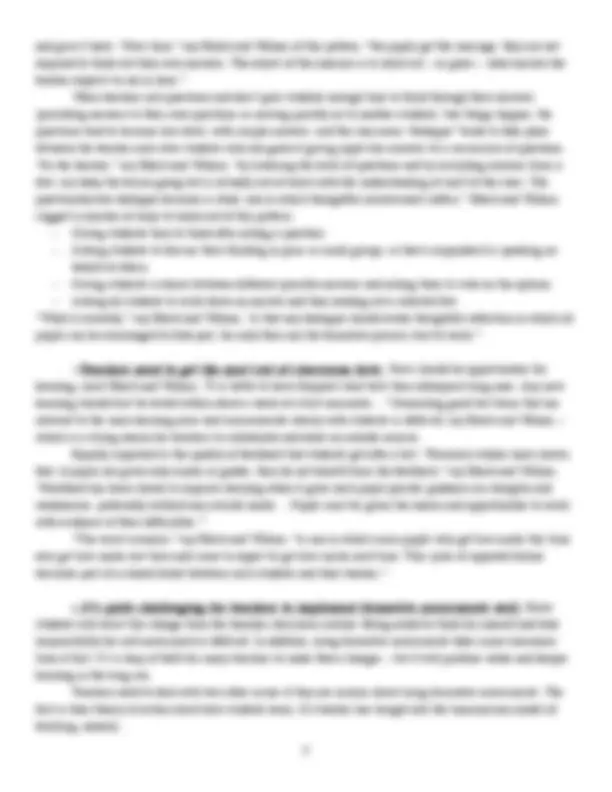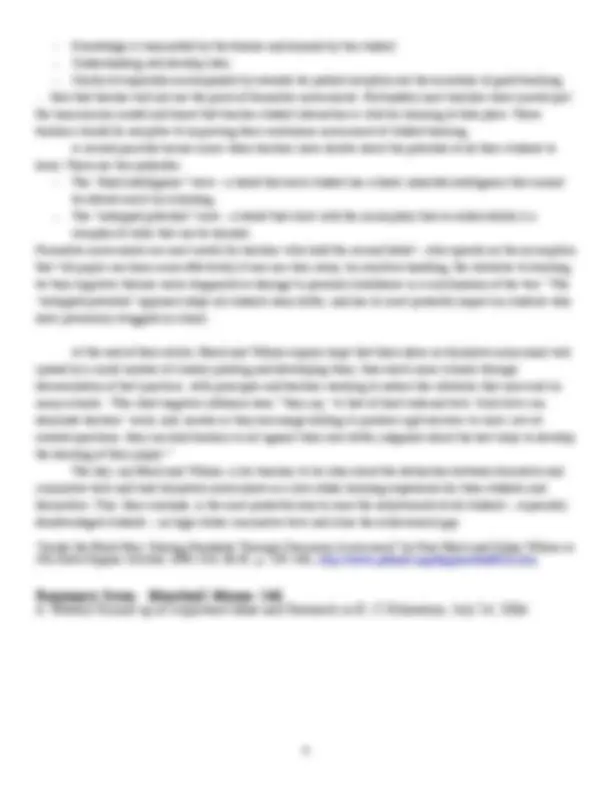




Study with the several resources on Docsity

Earn points by helping other students or get them with a premium plan


Prepare for your exams
Study with the several resources on Docsity

Earn points to download
Earn points by helping other students or get them with a premium plan
Community
Ask the community for help and clear up your study doubts
Discover the best universities in your country according to Docsity users
Free resources
Download our free guides on studying techniques, anxiety management strategies, and thesis advice from Docsity tutors
This article by paul black and dylan wiliam, published in kappan in 1998, highlights the importance of formative assessment in raising student achievement. The authors argue that minute-by-minute, day-by-day assessments and subsequent adaptation of instruction based on the results are key to getting high achievement from all students. They criticize the way many schools treat the classroom as a 'black box' and rely solely on high-stakes tests to improve learning.
What you will learn
Typology: Lecture notes
1 / 4

This page cannot be seen from the preview
Don't miss anything!



In this highly influential article in the October 1998 issue of Kappan, British professors Paul Black and
Dylan Wiliam discuss the evidence from 250 research studies on formative assessment and argue that when
teachers use minute-by-minute, day-by-day assessments to check for understanding – and follow up by adapting
instruction to clear up their students’ confusions and misunderstandings – they are on the road to getting high
achievement from all their students. In fact, argue Black and Wiliam, this is a better way of raising standards
than external programs, and is the most powerful engine for closing the achievement gap.
Black and Wiliam don’t think most school reform efforts pay enough attention to what goes on inside
the classroom, treating it as a “black box” and assuming that the pressure of high-stakes tests will be enough to
get teachers to improve learning. “[I]t seems strange, even unfair,” they argue, “to leave the most difficult piece
of the standards-raising puzzle entirely to teachers. If there are ways in which policy makers and others can give
direct help and support to the everyday classroom task of achieving better learning, then surely these ways
ought to be pursued vigorously.” Black and Wiliam are on a mission to understand what goes on inside the
“black box” and provide research support for teachers’ best efforts. Here are their major points:
and Wiliam say the research supports this conclusion for students from kindergarten to college, in different
subject areas, and in different countries. Effect sizes range from 0.4 to 0.7, which is higher than most other
educational interventions. Interestingly, formative assessments have their most positive effect on low-achieving
students and therefore narrow the achievement gap.
But the authors admit that it’s not a simple matter to implement classroom assessments well. Research
indicates that effective use of assessments depends on teachers making significant changes in classroom
practice, modifying instruction based on formative data, getting students actively involved in the process, and
using these assessments – and students’ self-assessments – to improve motivation and self-esteem.
and move on with the curriculum – without using classroom data to adjust instruction or help struggling
students. “Marking is usually conscientious but often fails to offer guidance on how work can be improved,”
said a U.K. inspection report. “Information about pupil performance received by the teacher is insufficiently
used to inform subsequent work.” There are several other problems with the way many teachers use classroom
assessments:
Black and Wiliam then list a number of ways that schools can improve the use of formative assessments:
work, accompanied by advice on how to improve it, and should not compare students to each
other. “When the classroom culture focuses on rewards, ‘gold stars,’ grades, or class ranking,” write Black and
Wiliam, “then pupils look for ways to obtain the best marks rather than to improve their learning.” This leads
students to avoid difficult tasks for fear of not being successful and losing points. Students who don’t do well
come to believe that they lack innate ability and can’t do anything about that. They tend to avoid investing
effort in learning, are content to “get over,” and build up their self-esteem in other arenas.
Effective use of formative assessments reverses this negative culture. The message to students is that
their failures are temporary and can be fixed by effective effort. Classrooms that use assessments in this way
have a culture of success, backed by a belief that all students can achieve. This dynamic is especially helpful for
low-achieving students because the focus is on the specific problems they are having with their work and what
they can do to improve.
anyone is trying to learn,” say Black and Wiliam, “feedback about effort has three elements: recognition of the
desired goal, evidence about present position, and some understanding of a way to close the gap between the
two. All three must be understood to some degree by anyone before he or she can take action to improve
learning.” First and foremost, students need to have a clear picture of what they are supposed to be learning.
“Surprisingly and sadly,” continue the authors, “many pupils do not have such a picture, and they appear to
have become accustomed to receiving classroom teaching as an arbitrary sequence of exercises with no
overarching rationale. To overcome this pattern of passive reception requires hard and sustained work. When
pupils do acquire such an overview, they then become more committed and more effective as learners.”
understanding as a unit unfolds – and give them adequate wait-time to respond. Effective
teachers plan open-ended questions, classroom tasks, and homework assignments that develop and assess
student understanding of the big ideas and details of the unit in real time. Master teachers are also alert to
unexpected student responses. Less effective teachers tend to listen for the “right” answer and, quite
unconsciously, respond in ways that signal that there’s only one answer and the students’ job is to figure it out
… then that teacher will not see the point of formative assessments. Fortunately most teachers have moved past
the transmission model and know that teacher-student interaction is vital for learning to take place. These
teachers should be receptive to improving their continuous assessment of student learning.
A second possible barrier arises when teachers have doubts about the potential of all their students to
learn. There are two polarities:
Formative assessments are most useful for teachers who hold the second belief – who operate on the assumption
that “all pupils can learn more effectively if one can clear away, by sensitive handling, the obstacles to learning,
be they cognitive failures never diagnosed or damage to personal confidence or a combination of the two.” The
“untapped potential” approach helps all students learn better, and has its most powerful impact on students who
have previously struggled in school.
At the end of their article, Black and Wiliam express hope that these ideas on formative assessment will
spread by a small number of schools piloting and developing them, then reach more schools through
dissemination of best practices, with principals and teachers working to reduce the obstacles that now exist in
many schools. “The chief negative influence here,” they say, “is that of short external tests. Such tests can
dominate teachers’ work, and, insofar as they encourage drilling to produce right answers to short, out-of-
context questions, they can lead teachers to act against their own better judgment about the best ways to develop
the learning of their pupils.”
The key, say Black and Wiliam, is for teachers to be clear about the distinction between formative and
summative tests and treat formative assessments as a low-stakes learning experience for their students and
themselves. This, they conclude, is the most powerful way to raise the achievement of all students – especially
disadvantaged students – on high-stakes summative tests and close the achievement gap.
“Inside the Black Box: Raising Standards Through Classroom Assessment” by Paul Black and Dylan Wiliam in Phi Delta Kappan, October 1998 (Vol. 80 #2, p. 139-148), http://www.pdkintl.org/kappan/kbla9810.htm